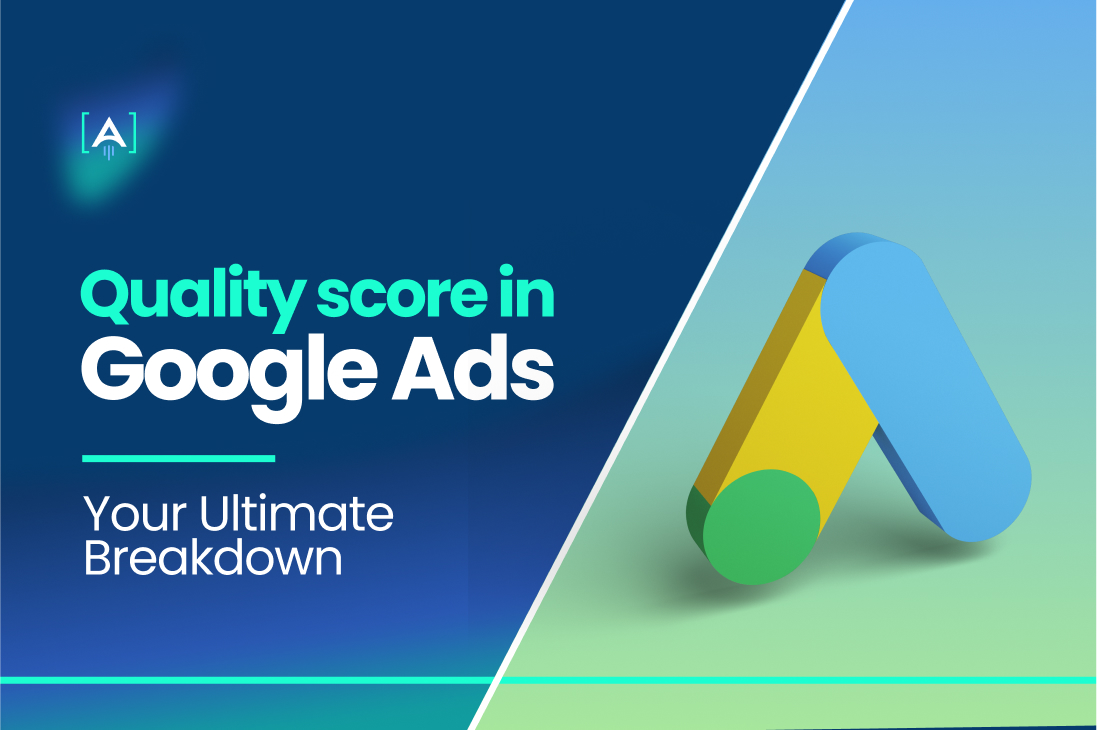Is there a secret sauce to ensuring your Google ads get noticed and bring in those desired clicks?
Yes, there is, and it’s called “Quality Score.”
We’ll explore Google Ads Quality Score, understand its relevance for different devices, debunk common misconceptions, and equip you with strategies to optimize it.
By the end, you’ll have the tools and knowledge to harness the power of Quality Score Google Ads campaigns, helping you reach your audience more effectively and drive better results with the expertise of our Google Ads Agency.
What is a Quality Score?

Quality Score Google Ads is your ad’s report card – it tells you how well your ad quality performs compared to other ads.
Simply put, a higher Google Ads Quality Score means your ad is more likely to provide what someone is searching for when they enter your chosen keyword, giving you a competitive edge.
By focusing on Google Ads optimization, you can improve your Quality Score, ensuring your ads are more relevant and effective in meeting user intent.
What Elements Does Quality Score Depend On?
Google Ads Quality Score formula is a blend of three key ingredients:
- Expected Clickthrough Rate: This is the chance your ad will grab potential customers’ attention and make them click.
- Landing Page Experience: How user-friendly and on-point your website is.
- Ad Relevance: How well your ad fits what a person is searching for.
On a scale of 1 to 10, the score rates the relevance and usefulness of your ad and landing page compared to others in the same arena.
Why is Quality Score Important in Google Ads?

Google Ads Quality Score is a powerful tool that can shape the destiny of your Google Ads campaigns.
Let’s break it down from two perspectives:
From Google’s Perspective: As the leading search engine, Google aims to provide users with a positive and valuable search experience, so your ad’s relevance plays a big part in this. A high Quality Score in Google Ads means your ad is more likely to do just that.
From an Advertisers’ Perspective: Quality Score in Google Ads impacts whether your ad can compete in keyword auctions, decides where it ranks, and can make your ad budget work better for you. That means a potential for higher ROI, even if you’re working with a limited budget.
Ad Rank Formulas

Let’s explore how Google decides to rank your ads. It’s not random; there’s some serious math involved.
The basic idea is pretty straightforward: Ad Rank = Bid Amount × Quality Score.
But let’s dive a bit deeper.
- Bid Amount: How much you’re willing to pay for a click. The higher your bid, the better your chances. Implementing effective Google Ads bidding strategies can help you maximize your budget and improve your ad placement.
- Quality Score: Quality Score, as we’ve discussed, rates the quality and relevance of your ad.
Google Search Network
Regarding the Google Search Network, your Ad Rank is vital.
Why? Because it decides if your ad shows up when someone searches for something related to your keywords.
The higher your Ad Rank, the better your ad’s position on the search results page.
The Role of Google Ads Attribution Models
Grasping how your ads drive conversions is vital for optimizing your Quality Score. Google Ads attribution models assist in identifying which points in the customer journey most effectively generate conversions.
You can understand how ads and keywords impact your overall performance by examining various models, including Last Click, First Click, and Data-Driven. This analysis helps refine your bidding strategies and ad placements, enhancing your Quality Score.
Leveraging Google Ads Performance Max
For a more automated approach, consider using Google Ads Performance Max campaigns. This new campaign type leverages machine learning to optimize your ad performance across all Google channels, including YouTube, Display, Search, Discover, Gmail, and Maps.
By automatically optimizing bids, budgets, audiences, and creative assets, Performance Max can help you achieve better results with less manual effort. Incorporating this tool into your strategy can positively impact your Quality Score by ensuring your ads are more relevant and effective across multiple platforms.
Google Display Network: Keyword-Targeted vs. Placement-Targeted
Now, things get more attractive on the Google Display Network. There are two ways your ads can appear: keyword-targeted and placement-targeted.
- Keyword-Targeted: This means your ad will appear on websites relevant to your chosen keywords. Your Ad Rank still matters here because it determines how often your ad gets displayed on these websites.
- Placement-Targeted: Here, you pick specific websites or placements where you want your ad to appear. In this case, your Ad Rank is still crucial because it can affect how often your ad is shown on those chosen sites.
You can also apply Google AdWords tips to increase your Quality Score.
Mobile Quality Score

In online ads, things can change depending on the device you’re using.
Mobile Quality Score in Google Ads is where this change becomes apparent. Understanding it can be the key to making your ads effective on smaller screens.
Basics and Relevance for Different Devices
Google keeps things fair for all devices – computers, iPads, smartphones, etc.
It applies the same rules to gauge your ads’ quality, whether potential customers surf the web on their computers or scroll on their smartphones.
It’s all about delivering the best experience, regardless of how your audience tunes in.
The Role of User and Business Location Proximity

Here’s a twist: Mobile Quality Score takes your location and the location of businesses into account.
Say you’re in the heart of the startup ecosystem, attending meetings and looking to connect with fellow founders and marketers. You pull out your phone and type in “startup events near me.”
Google uses its Mobile Quality Score superpowers to ensure the ads you see aren’t just any events but ones conveniently close to your current location.
Differences in Quality Score Between Mobile and Desktop Platforms
Mobile Quality Score kicks into high gear when someone’s on the move, looking for something nearby.
People in desktop mode might research more in-depth or spend time on websites.
In this context, the criteria for ad relevance might vary slightly.
That’s why your ad might look “more striking” on a smartphone – it’s because Mobile Quality Score puts a spotlight on location-based relevance, making your ad stand out when it matters most.
Common Misconceptions About Quality Score

Let’s uncover the truth behind misunderstandings about Google Ads Quality Score.
Myth 1: Match Type Changes Drastically Impact Quality Score
One common misconception is that altering your keyword match types, like switching from broad to exact match, directly impacts your Google Ads Quality Score.
The truth is keeping your keywords relevant and of high-quality matters.
Myth 2: Pausing Ads or Keywords Negatively Affects Quality Score
Many advertisers worry that hitting the pause button on a low-performing ad or keyword might harm their Google Ads Quality Score.
The truth is Google keeps historical data.
Your Google Ads Quality Score primarily depends on the performance of your currently active ads and keywords.
Therefore, pausing underperforming elements will not have any lasting negative impact on your score.
Myth 3: Display and Search Quality Scores Are Closely Linked
Some advertisers assume that achieving a high Google Ads Quality Score in one network (e.g., Search) will positively influence their Quality Score in the other network (e.g., Display).
The truth is these scores are calculated separately, each based on its distinct set of factors.
Myth 4: Ad Position Significantly Impacts Quality Score
Another misconception is securing a higher ad position leads to a better Quality Score.
The truth is Ad positions are influenced by your Ad Rank, which considers your Quality Score, among other factors.
Yet, your Quality Score isn’t directly affected by your ad’s position.
Instead, it contributes to achieving better positions by making your ad more competitive in the ad auction.
Myth 5: Historical Actions Haunt Your Quality Score Forever
Some advertisers worry that past issues could persistently haunt their Quality Score.
The truth is Quality Score is a dynamic metric that undergoes frequent recalculation.
How to Troubleshoot Low Quality Score

You may encounter the frustrating scenario of a low Google Quality Score. But it’s not the end of the world.
Here are some essential steps to check and boost that Quality Score.
Check and Optimize Destination URLs: Do your destination URLs lead users to relevant and user-friendly landing pages? Ensure that the page your ad directs people to aligns seamlessly with the keywords and ad copy.
Rewrite low CTR ads: Remember, you pay for every click on your ad, but not all clicks can bring conversions. So, your mission is to create high and meanwhile quality CTRs. Typically, most businesses’ average CTR falls around 7-9%. However, you’d aim for a bit higher, around 10-12%.
Here are some strategies for rewriting low-CTR ads:
- Use the Right Keywords: Are your keywords highly relevant to your ad and what users are searching for? Confidently use your competitors’ brand names and local and transactional keywords.
- Narrow Your Target Audience: Refine your audience selection. Use demographic, geographic, or behavioral targeting options to focus on a specific subset of your potential customers.
- Experiment with Different CTAs: Your CTA should invite your readers to ACT. Test various CTAs like “Learn More,” “Call Us,” “Save Your Time,” etc.
- Create Emotional Ads: Use emotional words, storytelling, and relatable scenarios to connect with your users and make them click.
- Use Ad Extensions Creatively: Experiment with various ad extensions, such as site links, callouts, or structured snippets, to provide additional information and entice users to click.
- Monitor and Respond to Quality Score Feedback in Google Ads Account: Take action if you notice specific keywords or ad groups consistently underperforming. This might involve rewriting ad copy, adjusting keyword bids, or refining targeting options.
- Ensure Optimal Site Speed: Nobody likes a slow website. It’s frustrating for users and also hurts your Quality Score. Factors that lead to slow load times include large images, excessive plugins, or server issues.
- Keep Your Landing Page Relevant: Your landing page should extend your ad, providing a seamless and relevant experience. Ensure that the content on your landing page is directly related to the ad’s message.
- Keep Your Ad Copy Fresh and Relevant: Regularly update your ad copy to keep it current and in sync with your offerings. Highlight new promotions or changes to keep users engaged.
Here are some tools for checking your site speed:
Importance of Account Audits and Campaign Restructuring
Sometimes, a fresh look at your campaign structure can reveal areas that need improvement.
Are your ad groups and keywords organized effectively? Are you targeting the right audience?
Restructuring your campaigns for better alignment and relevance can work wonders for Quality Score.
Quality Score Continuously Evolves

Google’s algorithms for calculating Quality Score are continuously changing to align with the evolving needs of users and advertisers.
What was important a year ago might not hold the same weight today. That’s why staying on top of the latest updates and trends is crucial.
The quality score calculated by Google isn’t a fixed number; it’s a dynamic assessment that considers various factors to determine the relevance and effectiveness of your ads.
Stay Updated
Google’s guidelines and practices can change. Keeping up ensures you’re on the right track. It helps you avoid pitfalls and issues affecting your ad performance.
So, like checking the weather forecast before heading out, stay updated with Google’s guidance.
The Essential Role of Quality Score in PPC Success

Google Ads Quality Score is integral to a successful Pay-Per-Click (PPC) strategy. A high Quality Score can lower ad costs and improve ad positions.
It ensures that your ads are showing to the right people, which boosts your chances of turning clicks into customers.
Quality Score can help your ads appear in better positions on the search results page, improve ROI, and bring you more satisfied customers.
We hope this blog post gave you practical insights on checking and improving your Quality Score.

